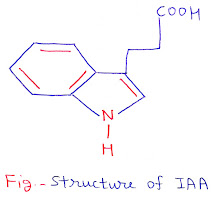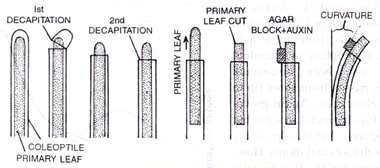Auxins: Chemical nature, Biosynthesis, Bioassay, Physiological effects and Mode of action
Auxins:-
> The word auxin is derived from a Greek word ‘Auxein’ which means ‘to grow’.
> It is found in SAM, RAM and young leaves of plants.
> Examples:-
i. IAA (Indole Acetic Acid):- Only natural auxin
ii. IBA (Indole Butyric Acid)
iii. NAA (Naphthalene Acetic Acid)
iv. 2,4-D (2,4-Dichlorophenoxy acetic acid):- a weedicide
v. 2,4,5-T (2,4,5-Trichlorophenoxy acetic acid)
vi. PIC (Picloram)
vii. PCPA (p – Chloro Phenoxy Acetic acid)
1. Discovery of Auxins:- Auxin was discovered and named by F. W. Went in 1928 by performing Avena curvature test. It is a bioassay for auxin-type growth regulators. The coleoptile stump of a decapitated seedling will curve in darkness after a small gelatin block containing auxin is placed on one side of a straight coleoptile stump.
2. Chemical Nature of Auxins:- Auxin is an indole derived phytohormone which is weakly acidic. It has an unsaturated ring structure. Auxins belong to a group of hormones that have indole structure. Indole has a bicyclic structure, consisting of a six-membered benzene ring fused to a five-membered ring.
3. Biosynthesis of Auxins:-
> It is biosynthesized from the amino acid tryptophan. Zinc ions are required for the synthesis of auxin. IAA or Indole acetic acid is structurally related to amino acid tryptophan.
Tryptophan dependent pathway:- Since the 1930s, when K.V. Thimann first observed the synthesis of IAA in the mold Rhizopus suinus, which had been fed the tryptophan, the conversion of tryptophan to IAA has been studied in vivo in more than 20 different plant species and in vitro with atleast 10 different cell free enzyme preparations.
> IPA pathway is found in most higher plants.
> Species generally not having IPA pathway have TAM pathway (here, deamination and decarboxylation reactions are reversed). Tomato has both IPA and TAM pathways.
> IAN pathway is mostly present in members of the families Brassicaceae, Poaceae, and
Musaceae. Recently, nitrilase like genes are identified in Cucurbitaceae, Solanaceae, Fabaceae,
and Rosaceae.
> IAM pathway is present in pathogenic bacteria.
4. Physiological Effects of Auxins:-
a. Tropism:- Response or orientation of a plant to a stimulus that acts with greater intensity from one direction than another. Growth due to tropism is mediated by changes in concentration of the plant hormone auxin within plant cells.
i. Phototropism (Heliotropism):- The orientation of a plant in response to light.
Positive:- Orientation towards the source of light.
Negative:- Orientation away from the source of light.
ii. Geotropism (Gravitropism):- The orientation of a plant in response to gravity.
Positive:- Orientation towards the gravity.
Negative:- Orientation away from the gravity.
b. Root initiation:- Auxin promotes growth of lateral and adventitious roots.
c. Flower initiation:- Auxin promotes flowering.
d. Apical dominance:- It is the dominance of shoot apex over its lateral branches. Here shoot apex inhibit the growth of lateral axillary buds. It is caused by the apical bud producing IAA (auxin) in abundance. The IAA causes the lateral buds to remain dormant.
e. Cell enlargement:- Its main function is of cell elongation. Far-red light induced increased internode elongation is a result of both increased cell elongation and increased cell division.
f. Prevention of Abscission:- Natural auxins have controlling influence on the abscission of leaves, fruits etc.
g. Respiration:- According to French and Beevers (1953), the auxin may increase the rate of respiration indirectly through increased supply of ADP (Adenosine diphosphate) by rapidly utilizing the ATP in the expanding cells.
h. Vascular Differentiation:- Auxin induces vascular differentiation in plants.
5. Bioassay of Auxins:-
It is testing of a biological activity like growth response of a substance by employing a living material like plant or plant part. Auxin bioassay is quantitative test as it measures concentration of auxin to produce the effect and the amount of effect.
a. Avena Curvature Test:-
> The test is based upon experiments of Went (1928). 10° curvature is produced by auxin concentration of 150 µg/litre at 25° C and 90% relative humidity. The test can measure auxin upto 300 pg/litre.
> Auxin from a shoot tip or any other plant organ is allowed to diffuse in a standard size agar block (generally 2 x 2 x 1 mm). Auxin can also be dissolved directly in agar. 15-30 mm long oat coleoptile grown in dark is held vertically over water. 1 mm tip of coleoptile is removed without injuring the primary leaf.
> After 3 hours a second decapitation is carried out for a distance of 4 mm. Primary leaf is now pulled loose and agar block supported against it at the tip of decapitated coleoptile. After 90-110 minutes, the coleoptile is found to have bent. The curvature is measured. It can also be photographed and the curvature known from shadow graph.
b. Root Growth Inhibition:-
Sterilized seeds of Cress are allowed to germinate on moist filter paper. As the roots reach a length of 1 cm or so, root lengths are measured. 50% of the seedlings are placed in a test solution while the remaining are allowed to grow over moist paper.
Lengths of the roots are measured after 48 hours. It is seen that the seedlings placed in test solution show very little root growth while root growth is normal in control seedlings.
6. Applications of Auxins:-
i. Rooting:- Besides indole acetic acid, some other synthetic auxins especially naphthalene acetic acid and indole butryic acid are widely employed in initiating early and vigorous rooting in plants which are propagated by cuttings.
ii. Prevention of Pre-Harvest Drop of Fruits:- Premature falling of the fruits can be checked by the application of auxins such as 2, 4-D and 2, 4 6-trichlorophenoxy acetic acid which delay the formation of the abscission layer.
iii. Parthenocarpy:- Parthenocarpic seedless fruits are obtained on commercial scale by the application of auxins in many plants.
iv. Inhibition of Buds to Prevent Sprouting:- Auxins like a-naphthalene acetic acid prolong the dormancy of buds in potato tubers and thus are very useful in preventing the eyes of potato tubers to sprout during storage.
v. Shortening of Internodes:- In apples and pear the fruits are developed on dwarf spurs. Treatment of the other terminal shoots with a-naphthalene acetic acid prevents the elongation of their internodes so that they also become dwarf. The latter may also bear the fruits.
vi. Selective Weed Killers:- At higher concentrations the auxins may have profound herbicidal properties and are utilised in the eradication of the weeds. The significance of their activity lies in their selective toxic action on plants. For instance 2, 4-dichIoro phenoxyacetic acid. (2, 4-D) is a potent weed killer and most of the broad-leaved dicotyledonous plants which occur as weeds are killed by this synthetic auxin, but usually the cereals (which are monocotyledonous) remain unaffected.
7. Mode of Action of Auxin:- Auxin causes Rapid increase in cell wall Extensibility. Cell wall enlargement in plants involves two steps:
i. Osmatic uptake of water across the plasma membrane resulting in increased turgor pressure of the cell.
ii. Extension of cell wall in response to increased turgor pressure.



%20of%202.jpeg)


